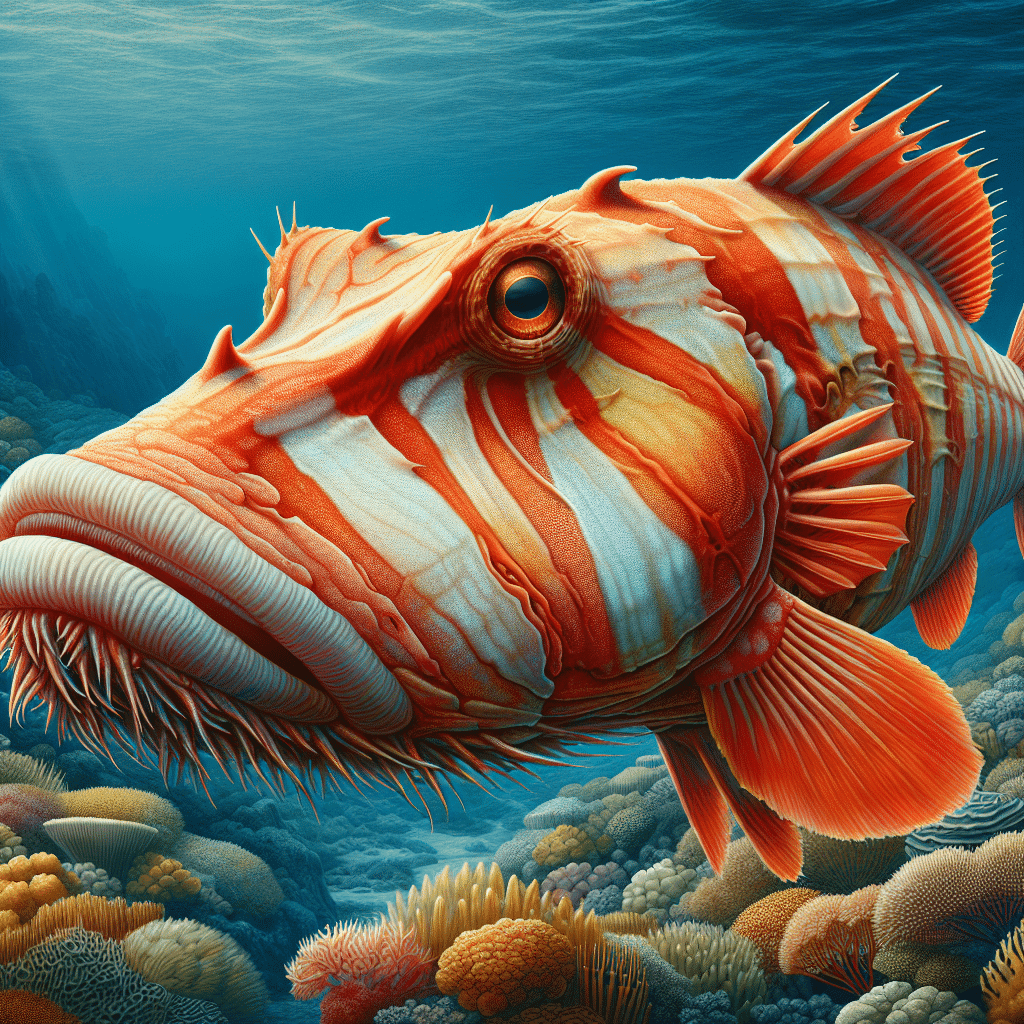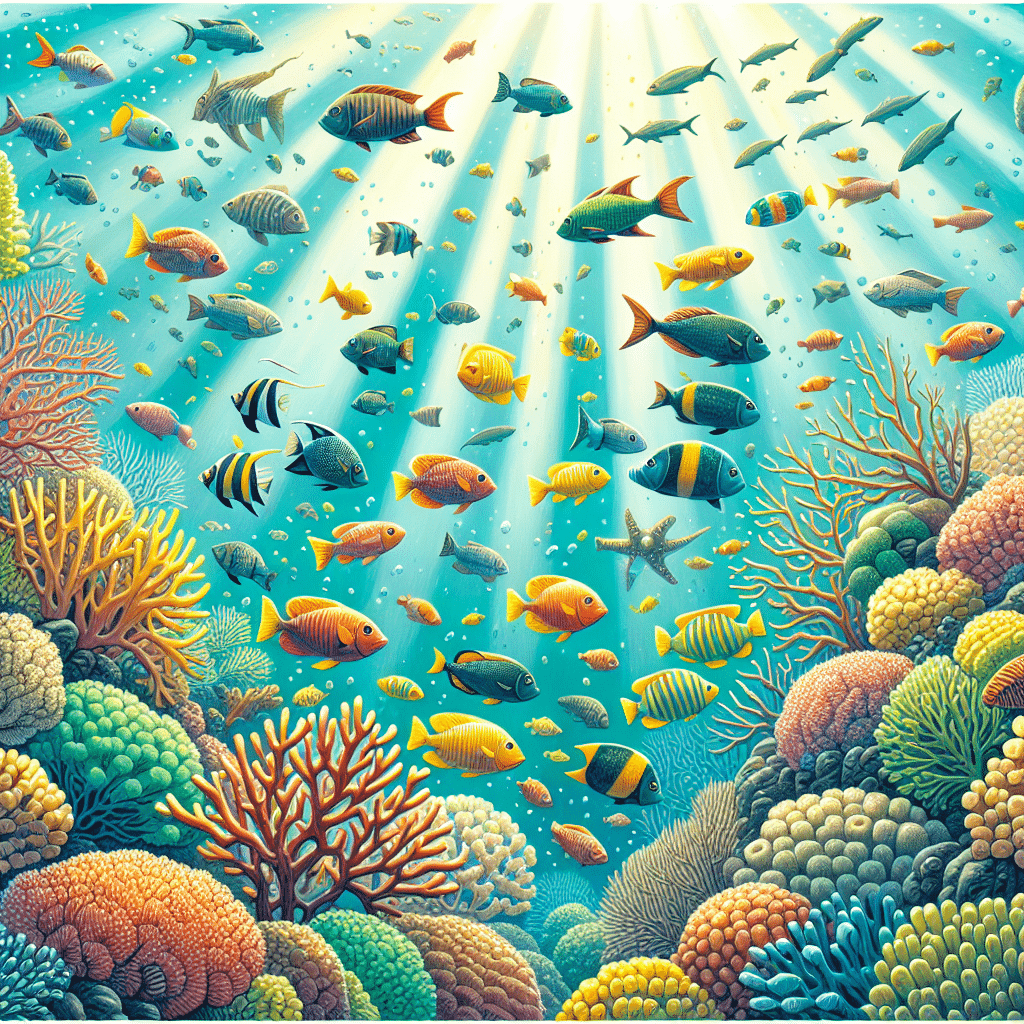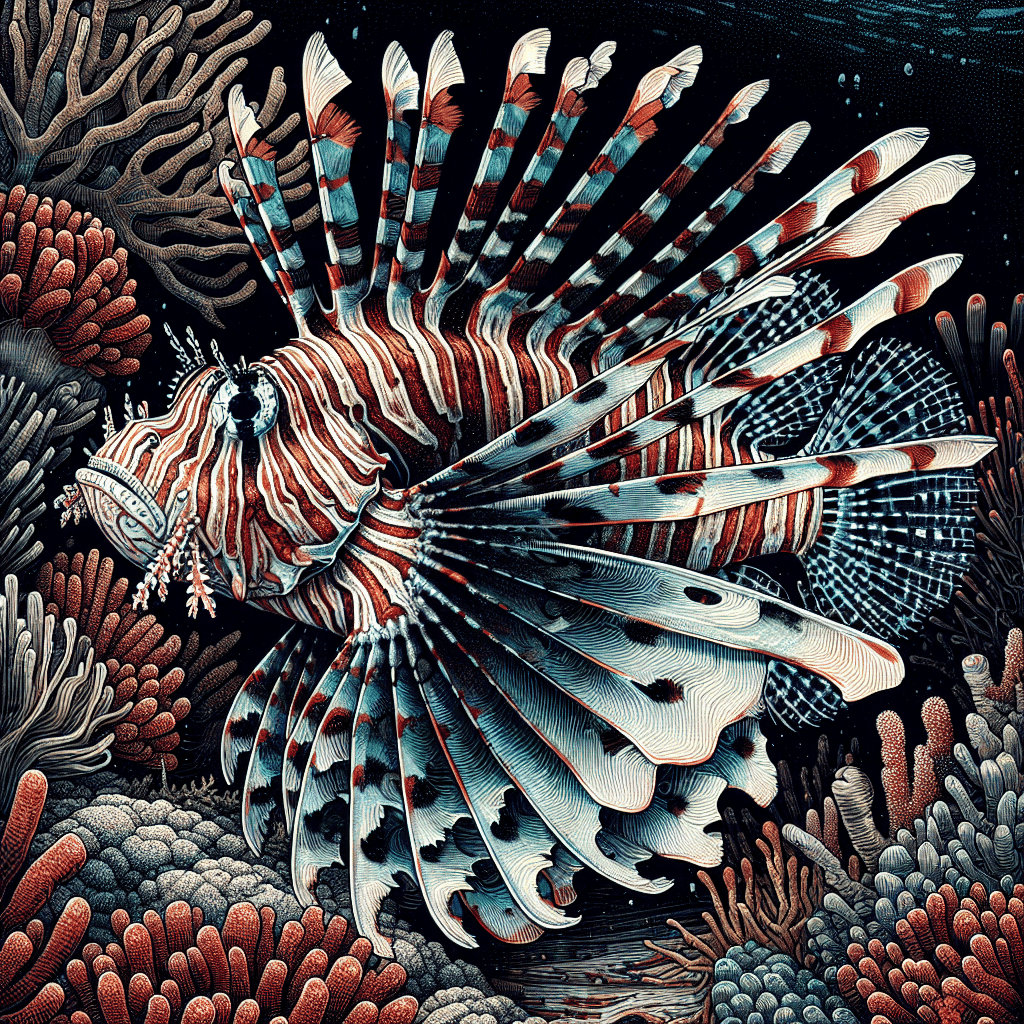Introduction to Hogfish
Overview of Hogfish
I’m excited to share some insights about hogfish, a fascinating species of wrasse that I’ve come to appreciate in the realm of reef tank fish. Hogfish are native to the Western Atlantic Ocean, with their range stretching from Nova Scotia, Canada, all the way down to northern South America, including the Gulf of Mexico. They thrive in areas rich in gorgonians and are known for their distinctive feeding habits, primarily consuming mollusks, crabs, and sea urchins. Their reputation as a tasty catch makes them a popular target among both spear and reef fishermen, which speaks to their desirability in both natural and aquarium settings.
To get a better grasp on what makes these fish unique, let’s take a look at some of their habitat and distribution.
Habitat and Distribution
Hogfish prefer living in warm, shallow waters where there’s plenty of structure and food sources. They are often found in reefs and rocky areas, which provide ample hiding spots and feeding opportunities. The table below summarizes their habitat preferences:
| Habitat Type | Description |
|---|---|
| Gorgonian Reefs | Abundant in food and hiding spots |
| Rocky Areas | Shelter from predators |
| Shallow Warm Waters | Optimal living conditions |
Understanding the natural habitat of hogfish can help me replicate these conditions in a reef tank environment. By creating a similar habitat, I can promote the well-being of these striking fish. If you’re interested in other marine species to consider for your tank, check out our articles on marine fish and grouper.
Physical Characteristics of Hogfish
Unique Features
The hogfish has some interesting and unique characteristics that make it stand out in the reef tank. One of the most notable features is its elongated snout, which it uses to search for crustaceans buried in the sediment. This snout is a key adaptation that helps it root around the ocean floor, giving it the nickname “hogfish” (Wikipedia).
Males are particularly distinctive with a deep, dark band that runs from the snout to the first dorsal spine, along with a lateral black spot behind the pectoral fins. These features not only help to identify males but also play a role in their behavior and social interactions.
| Feature | Description |
|---|---|
| Snout | Elongated, used for rooting in sediment |
| Male Identification | Dark band from snout to dorsal spine, lateral black spot |
| Maximum Length | 3 feet (0.91 m) |
| Maximum Weight | 22 pounds (10 kg) |
Coloration and Patterns
Hogfish exhibit a remarkable form of active camouflage, allowing them to blend seamlessly into their environment, whether it’s coral or sand. This camouflage is crucial for both hunting prey and avoiding predators (Wikipedia). Their coloration can vary, but they generally have a mix of pink, red, and green hues that enhance their ability to hide.
This ability to camouflage is especially important in a reef tank environment, as it helps the hogfish feel secure and reduces stress. Understanding their coloration and behavior can be beneficial for hobbyists looking to provide a comfortable habitat for these fascinating fish.
| Coloration | Description |
|---|---|
| General | Mix of pink, red, and green hues |
| Camouflage | Blends against coral or sand |
When considering adding hogfish to a reef tank, it’s essential to take their unique features and coloration into account to ensure they thrive in their new environment. For more information on keeping various types of fish, check out our articles on marine fish, triggerfish, and grouper.
Behavior and Reproduction
Feeding Habits
Hogfish are quite interesting when it comes to their feeding habits. They primarily feed on crustaceans and mollusks, using their specialized snouts to root around in the substrate of reefs and sandy bottoms. This behavior allows them to uncover hidden prey. I find it fascinating how they adapt their feeding techniques based on the availability of food and the environment they inhabit.
Here’s a table summarizing their diet:
| Food Type | Description |
|---|---|
| Crustaceans | Shrimp, crabs, and other shellfish |
| Mollusks | Snails and clams |
| Other Benthic Invertebrates | Various small marine organisms |
Social Structure
Hogfish are known for their unique social structure, which is organized into harems. Typically, one male hogfish will mate and protect a group of females within his territory (Wikipedia). This dynamic is quite interesting because it showcases a clear hierarchy in their social interactions.
During the breeding season, which peaks from November to June, particularly in March and April, males actively defend their territories and the females they mate with. They may even breed with the females daily during this period (Florida Fish and Wildlife Conservation Commission).
Interestingly, hogfish are also protogynous hermaphrodites. This means that females can transition into males as they grow older, usually around the age of three or when they reach lengths of about 14 inches (35.5 cm) (Florida Museum). This unique reproductive strategy helps maintain the balance within their harem structure, ensuring that there are enough males to mate with the females.
Understanding these behaviors and social structures is essential for anyone interested in keeping hogfish in a reef tank. Their social dynamics can influence how I set up my tank and the types of tank mates I choose.
Life Cycle of Hogfish
Understanding the life cycle of hogfish is fascinating, especially their unique reproductive strategy and growth patterns.
Sequential Hermaphroditism
Hogfish are known as sequential hermaphrodites, which means they start their life as females and can later transform into males. Typically, this transformation occurs around the age of three years and when they reach about 14 inches (35.5 cm) in length. This remarkable adaptation allows them to maximize their reproductive success. In the waters off South Florida, peak spawning for hogfish occurs from November through June, with a significant spike in February and March. During this period, males guard their harem and spawn exclusively with the females within it, ensuring the continuation of their lineage (Florida Museum).
Lifespan and Growth
Hogfish have been recorded to live up to 11 years, making them a long-lived species in the reef ecosystem. Their growth rate is closely tied to their environment and availability of food. They primarily feed on mollusks, crabs, and sea urchins, which contribute to their overall health and growth.
Here’s a quick overview of their growth stages:
| Age (Years) | Length (Inches) | Reproductive Stage |
|---|---|---|
| 1 | 6 | Female |
| 2 | 10 | Female |
| 3 | 14 | Transition to Male |
| 4-11 | 14+ | Male |
This table highlights how they start as females and transition to males, which is crucial for their reproduction strategy. For more on marine fish care, check out our section on marine fish. Understanding the life cycle of hogfish can help in effectively maintaining a healthy environment in reef tanks.
Care and Maintenance in Reef Tanks
When I decided to keep hogfish in my reef tank, I quickly learned that proper care and maintenance are essential for their well-being. Here, I’ll share my insights on tank setup and feeding requirements for these fascinating fish.
Tank Setup
Setting up the perfect environment for hogfish is crucial. These fish thrive in conditions that mimic their natural habitat, which consists of coral reefs and open bottoms. Here are some key points to consider for your tank setup:
| Feature | Recommendation |
|---|---|
| Tank Size | Minimum of 75 gallons |
| Water Temperature | 72-78°F (22-26°C) |
| Salinity | 1.020-1.025 specific gravity |
| pH Level | 8.1-8.4 |
| Substrate | Fine sand or crushed coral |
| Decorations | Live rock, gorgonians, and hard surfaces |
I usually ensure my tank has plenty of hiding spots and structures to promote the hogfish’s natural behavior. They prefer areas with hard sand and rock bottoms, so incorporating these elements can create a more comfortable environment for them.
Feeding Requirements
Feeding hogfish properly is key to their health. They are carnivorous and have specific dietary needs that reflect their natural diet in the wild. Here’s a breakdown of what to include in their diet:
| Food Type | Description |
|---|---|
| Mollusks | Clams, oysters, and snails are favorites |
| Crustaceans | Shrimp, crab, and other small crustaceans |
| Sea Urchins | Provide a good source of nutrition |
| Echinoderms | Include foods like sand dollars |
For adult hogfish, I tend to crush their prey with strong pharyngeal jaws, mimicking their natural feeding habits. Juvenile hogfish, on the other hand, thrive on a diet rich in crustaceans and mollusks. I usually feed my hogfish a mix of high-quality frozen foods and occasional live food to keep them interested and healthy.
Maintaining a consistent feeding schedule, along with monitoring their health, helps ensure that my hogfish remain happy and thriving in the tank. If you’re interested in learning more about other fish species that can coexist in your reef tank, you might find information on marine fish helpful.
Challenges in Keeping Hogfish
Keeping hogfish (often called hog snapper) in a reef tank can be a rewarding experience, but it also comes with its unique challenges. Understanding fish compatibility and disease prevention is essential for maintaining a healthy aquarium.
Compatibility with Other Fish
Hogfish are generally peaceful, but they can display territorial behavior, especially towards their own kind. When considering tank mates, it’s important to choose species that won’t provoke aggression. Some compatible fish include:
| Compatible Fish | Notes |
|---|---|
| Clownfish | Peaceful and can coexist well. |
| Blue Tang | Active swimmers; often a good match. |
| Butterfly Fish | Generally peaceful but needs space. |
| Mandarin Fish | Peaceful and prefers a calm environment. |
In contrast, it’s best to avoid more aggressive species like Lionfish or Triggerfish, as they can stress out hogfish or even cause harm. Always monitor interactions closely when introducing new fish to the tank.
Disease Prevention
Disease prevention is crucial for the health of hogfish and the entire reef ecosystem. Like all marine fish, hogfish can be susceptible to various illnesses. Here are some tips to help reduce the risk of disease:
Quarantine New Arrivals: Always quarantine new fish for at least two weeks before adding them to your main tank. This helps prevent the introduction of diseases.
Maintain Water Quality: Regularly check and maintain water parameters such as pH, salinity, and ammonia levels. Hogfish thrive in stable environments.
Proper Feeding: Provide a balanced diet that includes high-quality pellets, frozen foods, and fresh seafood. A well-fed fish is less likely to succumb to illness.
Regular Tank Maintenance: Perform routine water changes and clean the tank to prevent the buildup of harmful bacteria and parasites.
Be Aware of Ciguatera Poisoning: Hogfish consumption has been linked to ciguatera poisoning, which can affect humans. Ensure you’re informed about the risks if you plan on harvesting your fish. More information can be found through resources like Florida Museum.
By understanding the compatibility of hogfish with other species and implementing preventive measures against diseases, I can enjoy a vibrant and healthy reef tank filled with these beautiful fish. For more insights on caring for different marine species, check out our articles on marine fish and specific species like grouper or pufferfish.
Conservation Status of Hogfish
Threats to Population
Hogfish, also known as hog snapper, are highly sought after for their delicious taste, which has led to various threats to their population. The primary method of harvesting these fish is through spearfishing, which has become increasingly popular among both commercial and recreational fishermen. While hogfish are valued for their flesh, this demand has resulted in fishing pressure that has reduced their populations in certain areas.
Commercial catch rates for hogfish have been on a decline, particularly off the eastern coast of Florida, although they remain stable in the Gulf of Mexico. Over the past seven years, this decline has raised concerns about their long-term viability in those regions. Recreational catches have shown fluctuations without clear trends, but these variations highlight the impact of fishing activities on hogfish populations. Additionally, human consumption of hogfish poses a risk due to the potential for ciguatera poisoning, which can occur when eating fish that have fed on toxic algae Florida Museum.
| Threat Type | Impact on Hogfish Population |
|---|---|
| Commercial Fishing | Decreased catch rates |
| Recreational Fishing | Fluctuating populations |
| Ciguatera Poisoning | Health risks for consumers |
Conservation Efforts
To address the challenges facing hogfish populations, various conservation efforts are in place. Regulatory measures are implemented to manage fishing quotas and preserve the species. These measures aim to ensure sustainable fishing practices, which help maintain healthy hogfish populations.
Organizations and local governments also promote awareness about the importance of hogfish conservation, encouraging responsible fishing and consumption habits. By educating the public on the potential risks associated with ciguatera poisoning, especially when consuming hogfish, they aim to reduce demand for overfishing.
I find it essential for reef tank enthusiasts like me to stay informed about the conservation status of fish species we admire. Supporting sustainable practices and understanding the impact of our actions can contribute to the well-being of hogfish and other marine fish. For more information on different types of marine fish, check out our section on marine fish.
Interesting Facts about Hogfish
Ciguatera Poisoning
When enjoying hogfish, it’s essential to be aware of the potential health risks associated with its consumption. Hogfish has been linked to ciguatera poisoning, a type of food poisoning caused by eating fish that have accumulated toxins from microalgae in their environment. Symptoms can include nausea, vomiting, diarrhea, and neurological effects like tingling or numbness. It’s crucial for fish tank hobbyists and seafood lovers to stay informed about the risks of ciguatera, especially if they plan to eat hogfish.
Commercial Importance
Hogfish are highly valued in the culinary world, often marketed as a fresh or frozen food fish. They are primarily harvested by spearfishing, making them a popular target among both recreational and commercial fishers. Hogfish are also known as hog snapper, and their flesh is sought after for its excellent taste and texture. In fact, the state record for hogfish stands at an impressive 19 lb 8 oz, caught in Daytona Beach (Florida Fish and Wildlife Conservation Commission).
Over the years, commercial catch rates have fluctuated, particularly off the eastern coast of Florida, where populations have been impacted by fishing pressure. Despite this, the hogfish remains a desirable catch for fishing enthusiasts due to its delicious flavor and market value.
For more detailed information about hogfish and other marine fish species, check out our articles on marine fish and specific fish types like snapper and lionfish.



